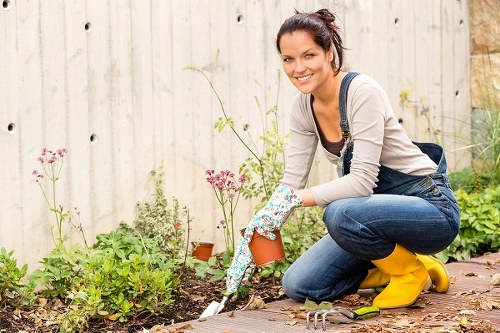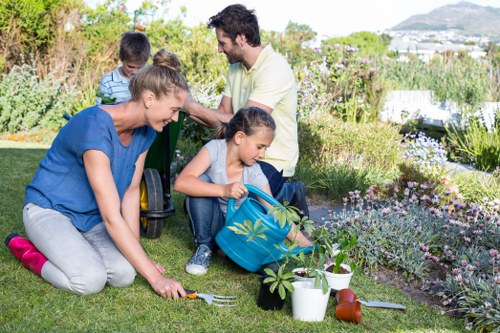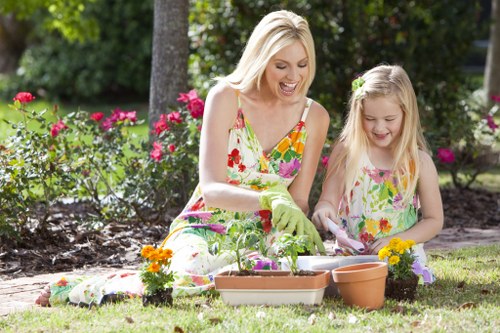Transform Your Outdoor Space: Landscape Gardening in Edmonton

Introduction to Landscape Gardening in Edmonton
Edmonton, with its unique climate and diverse soil conditions, offers a perfect canvas for landscape gardening. Whether you're a seasoned gardener or a beginner, understanding the intricacies of gardening in Edmonton can help you create a vibrant and sustainable outdoor space.
Landscape gardening is not just about planting flowers; it's about designing a harmonious environment that complements your home's architecture and enhances your lifestyle. From selecting the right plants to incorporating hardscape elements, every decision plays a crucial role in the overall aesthetic and functionality of your garden.
In this comprehensive article, we'll explore the essential aspects of landscape gardening in Edmonton, providing you with valuable insights and practical tips to turn your gardening dreams into reality.

Understanding Edmonton's Climate and Soil
Climate Considerations
Edmonton experiences a continental climate with cold winters and warm summers, which significantly impacts your gardening choices. Understanding Edmonton's climate is crucial for selecting plants that can thrive year-round.
The city has a relatively short growing season, typically from late May to early September. During this period, gardeners must maximize their planting strategies to ensure plants have adequate time to establish and flourish.
Additionally, Edmonton's weather can be unpredictable, with sudden temperature drops and rainfall. Implementing strategies to protect plants from extreme conditions is essential for maintaining a healthy garden.

Choosing the Right Plants for Edmonton Gardens
Perennials vs. Annuals
When selecting plants, it's important to differentiate between perennials and annuals. Perennials come back year after year, providing long-term structure and continuity in your garden. Examples suitable for Edmonton include Black-Eyed Susans, Coneflowers, and Hostas.
Annuals, on the other hand, complete their life cycle in one growing season. They are excellent for adding vibrant color and filling in gaps between perennials. Marigolds, Petunias, and Impatiens are popular choices.
Incorporating a mix of both can ensure your garden remains lively and attractive throughout the seasons.

Design Principles for Effective Landscape Gardening
Balance and Harmony
Achieving balance and harmony is fundamental in landscape gardening. Symmetrical designs convey a sense of order, while asymmetrical layouts can create a more natural and dynamic appearance.
Consider the proportions and scale of different elements in your garden. For example, pairing tall plants with shorter ones can create visual interest and prevent the garden from looking cluttered.
Incorporating various textures and colors also enhances the overall harmony, making your garden a feast for the eyes.

Hardscape Elements in Edmonton Gardens
Paths, Patios, and Walls
Hardscape elements like paths, patios, and walls add functionality and structure to your garden. They not only define different areas but also facilitate easy movement and access.
When selecting materials, consider durability and aesthetic appeal. Stone, brick, and concrete are popular choices that withstand Edmonton's weather conditions.
Integrating hardscape with softscape creates a cohesive look, enhancing the beauty and usability of your outdoor space.
Soil Preparation and Maintenance
Soil Testing and Amendment
Healthy soil is the foundation of successful landscape gardening. Conducting a soil test helps determine its pH level and nutrient content, guiding you in making necessary amendments.
Edmonton's soil can vary, but it often benefits from the addition of organic matter like compost to improve fertility and drainage.
Regular maintenance, including mulching and proper irrigation, ensures that your soil remains conducive to plant growth.
Irrigation Strategies for Edmonton Gardens
Efficient Watering Techniques
Proper irrigation is vital, especially given Edmonton's variable weather. Implementing efficient watering techniques conserves water and promotes healthy plant growth.
Consider drip irrigation systems that deliver water directly to the plant roots, minimizing evaporation and runoff. Additionally, scheduling watering during early morning or late evening reduces water loss.
Using rain barrels to collect and store rainwater can provide an eco-friendly water source, further enhancing your garden's sustainability.
Sustainable Practices in Landscape Gardening
Eco-Friendly Gardening Tips
Adopting sustainable practices not only benefits the environment but also ensures the longevity of your garden. Here are some tips to make your gardening efforts more eco-friendly:
- Choose native plants: They are well-adapted to the local climate and require less maintenance.
- Compost: Recycle organic waste to enrich your soil naturally.
- Use organic fertilizers: Avoid chemical fertilizers that can harm beneficial soil organisms.
- Implement pest control: Use natural predators and organic pesticides to manage pests.
Incorporating these practices fosters a healthy ecosystem within your garden.
Seasonal Gardening Tips for Edmonton
Spring Care
Spring is a crucial time for preparing your garden. Start by cleaning up winter debris and pruning dead branches from trees and shrubs.
Planting early-blooming flowers like crocuses and tulips can add immediate color to your garden as plants begin to grow.
Also, applying a balanced fertilizer helps your plants recover from winter dormancy and encourages robust growth.
Summer Maintenance
During the summer months, focus on maintaining adequate moisture levels. Regular watering, especially during dry spells, is essential.
Mulching helps retain soil moisture and suppresses weed growth. Additionally, deadheading spent flowers promotes continuous blooming.
Keep an eye out for pests and diseases, addressing issues promptly to prevent them from spreading.
Autumn Preparation
As autumn approaches, prepare your garden for the colder months by clearing fallen leaves and adding a layer of mulch to protect plant roots.
Planting hardy perennials and bulbs can ensure a vibrant garden ready to burst into life come spring.
Pruning and dividing plants during this season can also encourage healthy growth and prevent overcrowding.
Incorporating Lighting in Your Garden
Enhancing Ambiance and Safety
Outdoor lighting plays a significant role in landscape gardening. It not only enhances the ambiance but also improves safety and security around your property.
Pathway lights guide guests safely through your garden, while accent lighting highlights focal points like trees and water features.
Solar-powered lights are an eco-friendly option, reducing energy consumption while providing effective illumination.
Creating Functional Outdoor Spaces
Patios, Decks, and Seating Areas
Functional outdoor spaces like patios, decks, and seating areas extend your living space and provide a place to relax and entertain.
Choosing the right materials and layout ensures these areas are both aesthetically pleasing and practical.
Incorporate comfortable furniture, shade structures, and decorative elements to create inviting spaces that complement your garden's overall design.
Integrating Water Features
The Beauty of Ponds and Fountains
Water features add a serene and dynamic element to your garden. Whether it's a small pond, a fountain, or a birdbath, water can enhance the sensory experience.
Incorporating water features requires careful planning, considering factors like maintenance, placement, and the types of plants and wildlife you want to attract.
Properly integrated, water elements can become the centerpiece of your landscape, providing both beauty and tranquility.
Choosing the Right Garden Tools
Essential Equipment for Landscape Gardening
Having the right tools is essential for efficient and enjoyable landscape gardening. Invest in quality equipment that suits your gardening needs and makes maintenance tasks easier.
Some essential tools include:
- Hand trowel: Ideal for planting and transferring small plants.
- Pruners: Essential for trimming and shaping plants.
- Garden hose: Ensure it has adjustable nozzles for versatile watering options.
- Wheelbarrow: Useful for transporting soil, plants, and debris.
- Gloves: Protect your hands while working in the garden.
Maintaining your tools by cleaning and storing them properly extends their lifespan and ensures they're ready for use when needed.
Hiring Professional Landscape Gardeners in Edmonton
Benefits of Professional Services
While DIY gardening can be fulfilling, hiring professional landscape gardeners in Edmonton offers numerous benefits. Professionals bring expertise, experience, and a keen eye for design, ensuring your garden reaches its full potential.
They can assist with everything from initial design and plant selection to ongoing maintenance and problem-solving, allowing you to enjoy a beautiful garden without the hassle.
Moreover, professionals are well-versed in local regulations and best practices, ensuring your garden complies with city standards and thrives in Edmonton's specific environment.
Budgeting for Your Landscape Garden
Cost-Effective Gardening Solutions
Creating a stunning landscape garden doesn't have to break the bank. With careful planning and budgeting, you can achieve your gardening goals affordably.
Here are some cost-effective solutions:
- Plan Ahead: A well-thought-out plan minimizes unexpected expenses and ensures efficient use of resources.
- DIY Projects: Handling some tasks yourself, like planting and mulching, can save labor costs.
- Choose Affordable Plants: Opt for native and hardy plants that require less maintenance and replacement.
- Reuse Materials: Repurposing materials like old bricks or reclaimed wood adds character without additional costs.
Additionally, prioritizing high-impact areas can help you allocate your budget where it matters most, creating a visually appealing garden without excessive spending.
Maximizing Space in Small Gardens
Innovative Gardening Techniques
Even with limited space, you can create a beautiful and functional landscape garden in Edmonton. Implementing innovative techniques helps maximize every inch of your garden.
Vertical gardening is an excellent way to add greenery without occupying ground space. Using trellises, wall-mounted planters, and vertical shelving can enhance your garden's depth and dimension.
Container gardening allows for flexibility, enabling you to move plants as needed and adjust your garden layout effortlessly. Choose containers that complement your garden's aesthetic and provide adequate drainage for healthy plant growth.
Seasonal Planting Calendar
Optimizing Plant Growth Throughout the Year
Following a seasonal planting calendar ensures your garden remains vibrant and productive throughout the year. Here's a month-by-month guide tailored for Edmonton's climate:
- March-April: Start planting cool-season vegetables and hardy perennials. Prepare soil and apply compost.
- May: Plant annuals, shrubs, and trees after the last frost. Begin summer maintenance.
- June-August: Focus on watering, weeding, and harvesting. Monitor for pests and diseases.
- September: Start planting spring bulbs and prepare your garden for autumn.
- October-November: Clean up garden beds, mulch, and protect sensitive plants from the cold.
- December-February: Plan for the upcoming year, repair tools, and order seeds.
Adhering to this calendar helps you stay organized and ensures timely care for your plants, promoting a healthy and thriving garden.
Pest Management in Edmonton Gardens
Protecting Your Plants Naturally
Pest management is a crucial aspect of landscape gardening. Adopting natural and eco-friendly methods helps maintain a healthy garden without harming beneficial insects or the environment.
Here are some strategies for effective pest control:
- Introduce Beneficial Insects: Ladybugs and lacewings can help control aphids and other common pests.
- Use Organic Pesticides: Neem oil and insecticidal soaps are effective against a variety of pests without the harmful effects of chemical pesticides.
- Encourage Plant Diversity: A diverse garden attracts a balance of insects, reducing the likelihood of pest infestations.
- Regular Inspection: Routinely check your plants for signs of pests and address issues promptly.
Implementing these natural pest management techniques fosters a resilient and balanced garden ecosystem.
Edmonton's Best Plants for Landscaping
Top Choices for Your Garden
Selecting the right plants is pivotal for a thriving landscape garden. Here are some of Edmonton's best plants for landscaping:
- Sedum: Known for its hardiness and low maintenance, Sedum adds texture and color.
- Hostas: Excellent for shaded areas, Hostas provide lush foliage and variety.
- Daylilies: These resilient perennials offer vibrant blooms and adaptability.
- Grasses: Ornamental grasses add movement and soften landscape lines.
- Conifers: Evergreen conifers provide year-round structure and privacy.
Incorporating these plants ensures a beautiful and sustainable garden that thrives in Edmonton's environment.
Edmonton's Landscape Gardening Trends
What's Popular Right Now
Staying updated with the latest landscape gardening trends can inspire your garden design and keep it modern and appealing. Some current trends in Edmonton include:
- Native Plant Gardens: Emphasizing local flora for sustainability and ease of maintenance.
- Minimalist Designs: Clean lines and simple layouts create elegant and unobtrusive gardens.
- Edible Landscaping: Integrating vegetables, herbs, and fruit-bearing plants into ornamental gardens.
- Water Conservation: Implementing drought-resistant plants and efficient irrigation systems.
- Outdoor Living Spaces: Expanding garden areas to include kitchens, lounges, and dining spaces.
Incorporating these trends can enhance your garden's functionality and aesthetic appeal.
DIY vs. Professional Landscape Gardening
Making the Right Choice
Deciding between DIY and hiring a professional can significantly impact your garden's outcome. Here are some factors to consider:
- Budget: DIY can be cost-effective, but professional services may offer long-term savings through expertise.
- Time: Assess whether you have the time to dedicate to gardening tasks or if you'd prefer to delegate them.
- Expertise: Professionals bring specialized knowledge that can enhance your garden's design and maintenance.
- Scale of Project: Larger or more complex projects may benefit from professional planning and execution.
Ultimately, the choice depends on your personal preferences, resources, and the specific needs of your garden.
Final Thoughts on Landscape Gardening in Edmonton
Create Your Dream Garden Today
Embarking on a landscape gardening journey in Edmonton is a rewarding endeavor that can transform your outdoor space into a personal sanctuary. By understanding the local climate, selecting appropriate plants, and implementing effective design and maintenance strategies, you can cultivate a beautiful and sustainable garden.
Whether you choose to go the DIY route or enlist the help of professionals, the key is to plan thoughtfully and invest time and care into your garden. With dedication and creativity, your Edmonton garden can become a stunning extension of your home, providing joy and relaxation for years to come.
Contact us today to start designing your perfect landscape garden or book your service now and take the first step towards a greener, more beautiful outdoor space.

